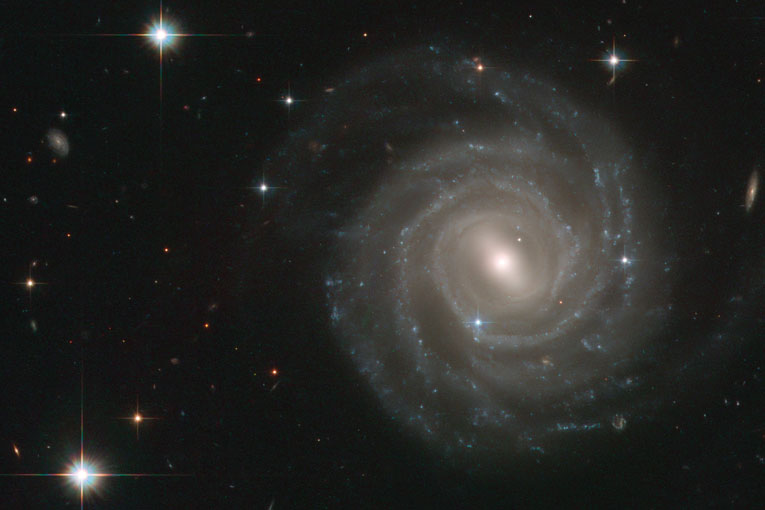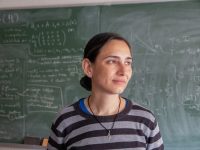 ESA/Hubble & NASA ESA/Hubble & NASATravelling at hyperluminal speeds would open to humanity the possibility of exploring the whole galaxy, and even, perhaps, other galaxies. In the image, the UGC 12158, photographed by the Hubble space telescope. It is believed to be a virtual twin of our own galaxy, the Milky Way. |
||
|
If there is a recurrent idea in science fiction it is that of hyperluminal travel. Virtually all the production of the space opera subgenre depends on it, since distances in the universe are enormous and travelling through ordinary means is incomprehensible in human terms. An example: if there was a physical race from here to Pluto, and we wanted to take the car (of course, at a maximum speed of 120 km/h so we are not fined), it would take us almost 6,000 years. And that is talking about the Earth’s neighbourhood; driving a car to the nearest star, Proxima Centauri, would take us 35 million years. Of course, we can go faster. But not much nowadays! The fastest spacecraft, the Voyager I, travels at 56,000 km/h. If it went to Proxima Centauri, it would take 80,000 years to arrive. Can you imagine a television series with such pace? Actually, if we got very close to the speed of light, relativistic time dilation would allow us to get to the other end of the galaxy in, maybe, just a few years. But outside the spacecraft time follows another rhythm, and hundreds of thousands of years would have passed on Earth. If the travellers went back to Earth they would find nothing recognisable (nor would they find human beings). Such a type of exploration is just a one-way journey. If we want to explore the galaxy and return to tell our friends the tale, or maintain a galactic empire, we need to pierce the light barrier. Is it possible? Hyperluminal speeds are not unknown: if you project a powerful laser pointer on the Moon and quickly move your wrist, the point of light will move over the lunar surface faster than light. The Andromeda Galaxy, at two million light-years from our reference point, gives a turn around the Earth every 24 hours with an apparent speed thousands of millions times faster than light’s; and it is well known that entangled quantum particles instantaneously «transmit» their state to their partner, however far away they might be. There are more examples, but none allows to transmit information between two points at hyperluminal speeds. Which is just what relativity prohibits; and that includes a spacecraft carrying a large sack of mail. If we try a frontal attack, we will soon find an impassable wall. As the spacecraft approaches the speed of light, it increasingly needs greater effort to gain speed. In many senses it is as if the energy it consumes accelerating increased its mass. To finally reach the speed of light, an endless amount of energy is needed. More than there is in the entire universe. And what if we do not make a frontal attack but we take a shortcut? General relativity predicts the possibility of said shortcuts: wormholes, a sort of spacial and temporal bridge that, in some cases, would allow a human to travel from one side of the hole to the other. Thus, making a brief trip inside the wormhole we get out maybe thousands of light-years away. For practical purposes, we have travelled faster than light. But the practical problems are immense. To make one so big that a human may pass through it we would have to concentrate stellar quantities of mass in a diminutive space. They would also be unstable and disintegrate in milliseconds. Besides, quantum fluctuations make it impossible to predict where the other end of the wormhole would open. At least, to prevent it from disintegrating, there is a trick: to fill its throat with exotic matter, a theoretical substance with the density of negative energy, which means that it would weight less than nothing! It works as a gravitational repellent and prevents the bridge from collapsing. With its channel full of exotic matter it would be possible to go through it with relative safety. Of course, we do not know if this type of matter really exists, which is highly speculative, but phenomena such as the Casimir effect present a behaviour that is equivalent to a negative density of energy, leaving the door open to hope. Another approach that is compatible with relativity is Alcubierre’s warp drive, which entails moving a bubble of space and time by contracting the space before it and expanding it behind it (again, using exotic matter). The spacecraft would be inside the bubble, idling in terms of space, and therefore not violating relativity; this spatial-temporal bubble would be the one going at hyperluminal speeds. Do these methods solve the problem? No. When we stretch the cape to cover up the broken seams of one side, the other side tears up. In this case the rip is called «time paradox» and appears in any method of hyperluminal travel that we can imagine, since the faster-than-light travel is the equivalent of a time machine. It turns out that when I move with respect to you, our systems of spatial and temporal reference are not parallel. They form instead a certain angle, and the bigger the difference of speeds, the bigger the angle. It is therefore possible to define a point of space and time that for me is in the past and for you, in the future. To reach that point, we both need to travel faster than light. In a normal universe this is impossible and there is no problem. But if we allow hyperluminal travel, problems arise: suppose that at some point there is a murder. Since for me that event is in the past, I could get a hyperluminal warning telling me what has happened. I tell you, and since for you it is a future event, you can still travel there hyperluminally and prevent it. And here we have a paradox. That is to say, a universe that can be inconsistent with itself. How is that solved? Either hyperluminal travel is impossible, or there must be some way to avoid temporal paradoxes. But that will be a subject for another article. |
«The fastest spacecraft, the Voyager I, travels at 56,000 km/h. If it went to Proxima Centauri, it would take it 80,000 years to arrive. Can you imagine a television series with such pace?» | |
Search
© Mètode 2012 - 74. Online only. The Enchanted Cove - Summer 2012





